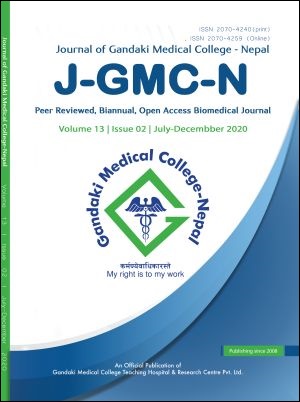Indications for removal of impacted mandibular third molars and associated pathologies
DOI:
https://doi.org/10.3126/jgmcn.v13i2.31947Keywords:
impacted mandibular third molar, indication, pathology, surgical extractionAbstract
Introduction: The purpose of this study was to assess the various indications of impacted mandibular third molar removal and pathologies associated with it.
Methods: A retrospective cross-sectional study was conducted in the Department of Oral Surgery, Gandaki Medical College. The clinical case records from September 2016 to August 2019 were retrieved, reviewed, and analyzed. Surgically removed impacted mandibular third molars for which orthopantomogram were available and the lesions verified histologically were included in the study. Orthopantomograms were studied to determine the angular position of the impacted mandibular third molars and associated pathology. The data was entered in SPSS 20 and descriptive statistics was applied.
Results: A total of 1344 impacted mandibular third molars (Male-709, 52.8%; Female - 635, 47.2%) were surgically extracted during the three-year period. The majority of patients (36.5%) were in the age groups of 25 - 34 years with a higher incidence of mesioangular impaction (33%). Recurrent pericoronitis (62.9%) was the most common indication followed by caries (11.7%). The radiographically detectable lesion was seen in 471 (35%) cases out of which 304 (64.5%) were symptomatic at the time of extraction. Among137 histopathologically diagnosed cases, chronic inflammatory lesion (76, 55.9%) was the most common finding.
Conclusion: Awareness of the indications for removal of impacted mandibular third molars helps in proper management and prevention of future complications associated with retention and delayed extraction of such teeth. So, regular and periodic clinical and radiographic examination is required for patients with impacted mandibular third molars.
Downloads
Downloads
Published
How to Cite
Issue
Section
License
This license allows reusers to distribute, remix, adapt, and build upon the material in any medium or format for noncommercial purposes only, and only so long as attribution is given to the creator.




